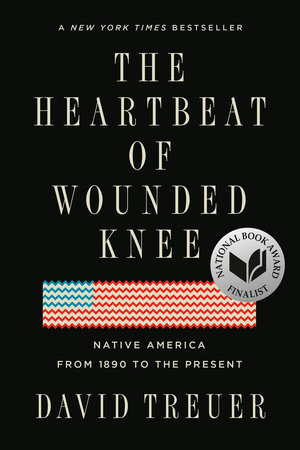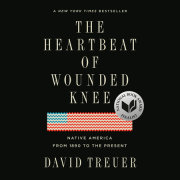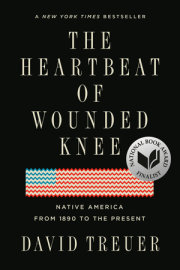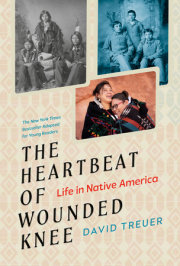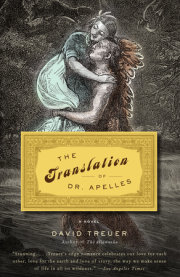Meetings and Beginnings
There is a tendency to view the European settlement of North America, and the corresponding decimation of many tribes and cultures, as sudden and inevitable. It was neither. How, then, did Indians go from being the lords of the continent-controlling all its shores, all the interior, having mastered its climates and terrain and even the inevitable conflict with other tribes-to the scattered remnants present in 1891?
Although the northern Atlantic littoral had been reached and lightly explored by Leif Eriksson (Eriksson the Lucky) in the eleventh century, it wasn't until Christopher Columbus landed in the Bahamas on October 12, 1492, that the age of exploration (and eventually settlement) of the New World truly began. And that is where the story of America usually begins. Like many origin myths, the idea that everything began in 1492 when Columbus sailed the ocean blue is a fiction. So, too, are the received notions about why he came: his journey wasn't motivated by ideology or by the desire to prove that the earth was round. Columbus's journey to North America was a mission that would resemble the worst kind of marriage: he came for money and ended up in court.
In many ways, his journey began with the Ottomans and with the rise of a mercantile class-early monopolists, if you will. Prior to 1453, the Silk Road that led from Europe through the Middle East and the subcontinent to China was protected, known, and stable enough to facilitate a robust trade in silk and spices between Asia and Europe. Since at least 3000 bce, spices had been traded from east to west via coastal routes, and, later, by sea routes. Cinnamon, nutmeg, ebony, silk, obsidian, and all manner of goods moved from east to west, while gold, silver, and gems moved from west to east. A host of other things followed along those routes: religions, populations, knowledge, philosophy, genes, and disease. The relationships that evolved, from antiquity through the Middle Ages, while not necessarily equitable and certainly not always peaceful, weren't only, or even primarily, exploitive. When the Ottoman Turks conquered Constantinople in 1453, however, the ensuing regime change dismantled that network. The powers in Venice, Genoa, Barcelona, and Lisbon needed new ways to get the goods to which they were accustomed into Europe. Specifically, they needed a cheaper way than traveling through the politically unstable Mediterranean waters and the increasingly risky overland routes across the Arabian Peninsula. Political unrest was widespread, as were piracy and violence.
Making matters worse were Iberian civil wars and a kind of economic headlock imposed on European royal power by feudal mercantilism. Spain wasn't exactly Spain until the end of the fifteenth century; it was a collection of competing states including Portugal, Castile, Granada, and Navarre, united through conquest and the marriage of Isabella and Ferdinand. The Spanish crown in particular had depleted its resources in punitive wars against other Iberian countries and against the Moors, who were finally expelled from Spain in the late 1400s. Though driven from Spain, the Moors were still a force in the Mediterranean, and they effectively choked off trade to Spain's courts. (The effects were dramatic; for example, by 1503 pepper traded through the Mediterranean cost 80 percent more than pepper that came from the New World). Merchants, long denied standing and opportunity in their home countries in favor of royal companies, had in the meantime developed their own foreign trade networks, and they became rich, in some cases richer than the crown. Then, as now, power followed money; European monarchies were losing their grip. What the Portuguese and Spanish (and later the English) crowns needed were royal charters and royal commerce: a way to create central banks as a means of consolidating power, and state-sponsored businesses to fill royal coffers. And although it had long been thought possible, it wasn't until the mid-fifteenth century that it became practical and necessary to try to sail west in order to reach the East. Columbus was a hired gun. The Spanish crown needed someone to advance its interests. Like a gun, Columbus, as a representative of power, quickly became an agent of violence.
Michele da Cuneo, a lifelong friend of Columbus's who came along on the second voyage, is indicative of the scope of violence the expedition entailed:
While I was in the boat, I captured a very beautiful Carib woman, whom the said Lord Admiral gave to me. When I had taken her to my cabin she was naked-as was their custom. I was filled with a desire to take my pleasure with her and attempted to satisfy my desire. She was unwilling, and so treated me with her nails that I wished I had never begun. But-to cut a long story short-I then took a piece of rope and whipped her soundly, and she let forth such incredible screams that you would not have believed your ears. Eventually we came to such terms, I assure you, that you would have thought that she had been brought up in a school for whores.
In 1495, Columbus shipped 550 Indians in four ships back to Spain for sale. More than two hundred died en route, and their bodies were cast into the sea. By 1499, Columbus was regularly shipping Indians back to Spain, where they were sold in Andalusian markets. While he was funneling Native families into slavery and breaking them apart, his own brothers-Bartholomew and Diego (Giacomo)-joined him in his exploits in the New World. Ferdinand and Isabella were reluctant to allow him to continue slaving, even though slavery was alive and well and widespread in Spain at the time. Muslims who remained after 1492 were sold, as were any "'enemies of the Catholic church and of the crown' who had been taken in a 'good' or 'just' war." Isabella and Ferdinand needed to know if Indian captives met these definitions (although slavers and profiteers and functionaries almost always found a way to make most of their captives fit administratively). The monarchs told Columbus to stop slaving until they figured out what to do. They appointed a committee of lawyers and religious leaders to help them. It took five years for them to reach a decision, during which time Columbus kept slaving and exploring. He was so insistent and pressured the crown so relentlessly while it deliberated that Isabella, exasperated, exclaimed, "Who is this Columbus who dares give out my vassals as slaves?" But eventually he realized it would be more profitable to keep Indians in the New World in slavery than to send them back to Spanish markets. Columbus wrote that he "would have sent many Indians to Castile, and they would have been sold, and they would have become instructed in our Holy Faith and our customs, and then they would have returned to their lands to teach the others," but the Indians stayed in the Caribbean because "the Indians of Espa–ola were and are the greatest wealth of the island, because they are the ones who dig, and harvest, and collect the bread and other supplies, and gather the gold from the mines, and do all the work of men and beasts alike." In short, while Columbus found gold and silver and other natural resources, the indigenous lives and bodies were the greatest natural resource he came upon.
Schisms emerged. When Columbus returned on his third voyage in 1498, he was greeted by an insurrection at Hispaniola. The colonists claimed he had misled them about the opportunities to be found there. Columbus had some of them hanged for insubordination. Others returned to Spain, where they brought a case against him in the Spanish court. Columbus also ran afoul of the Church for his reluctance to baptize many Native peoples because he preferred to leave them, according to church doctrine, "soulless," which meant that they were free to be enslaved. In 1500 he was removed as governor of Hispaniola and brought to Spain in chains to face charges of cruelty and mismanagement. Not until 2006 did documents surface in Spain that detailed the extent of Columbus's tyranny and depravity. The governor who replaced him, Francisco de Bobadilla, tasked by the crown with fact-finding on the Columbus brothers' rule, deposed twenty-three people, some supporters, some enemies. All had the same tale to tell: the brothers had used torture and mutilation as a means of control. A man convicted of stealing corn had his ears and nose cut off and was sold into slavery; a woman who suggested Columbus was of low birth was paraded naked through the streets and later had her tongue cut out; Natives who rose up against the brutalities of colonial rule were dismembered alive and had their torsos paraded through the streets.
Columbus was somewhat rehabilitated in the eyes of the crown, and he was allowed to return to the Caribbean on a fourth voyage in 1502 with strict instructions not to stop at Hispaniola. But he was ever the same. Things were so bad during his fourth voyage that Columbus was stranded on Jamaica for the better part of a year after sustaining damage in a storm; Nicol‡s de Ovando y C‡ceres, the governor of Hispaniola, who detested Columbus, refused to help him. When aid from Spain finally arrived in June 1504, Columbus returned there for good, never having set foot on the mainland of North America.
Starting in the 1490s and over the next twenty years, John Cabot would reach Atlantic Canada, Jo‹o Fernandes Lavrador would map Labrador, and the Corte-Real brothers would explore the region as well. Juan Ponce de Le—n would found Caparra on what is now Puerto Rico, and Hern‡n CortŽs would conquer Mexico with the help of the Tlaxcalans, as more than forty thousand renegade Inca subjects would aid Francisco Pizarro with his efforts farther south. And through the end of the century, a wave of exploration and many attempts at colonization would follow. The Spanish fought for a foothold in North America, attempting settlements in the area that is now South Carolina in 1526 and again in 1566. Norman, Breton, and Portuguese fishermen were settling Newfoundland by 1527, Huguenots tried Saint Kitts in 1538, the Spanish Pensacola in 1559, and the French Fort Caroline near present-day Jacksonville in 1564 and Chesapeake Bay in 1570. The English settled Roanoke Island in 1585 and Sable Island in 1598. These early attempts failed for a number of reasons: disease, starvation, attack by indigenous tribes, attacks from other colonial powers (Spain was a particularly unapologetic underminer of other colonial efforts). During this period the colonial powers shifted their focus from exploitative colonization (small enclaves of people sent far from their homeland in order to extract resources to be sent back to Europe) to exploitive settlement (permanent communities established to extract and improve upon resources for profit). Many of the early settlements failed because they were looking for a quick buck (gold, slaves); others succeeded when they went for the slow buck: cotton, tobacco, timber, furs, slave-worked gold and silver mines, and gems. How different parts of North America were colonized depended to a great extent on which Europeans were setting up shop. The Spanish attempted Catholic missions in Mexico, Florida, and New Mexico that burned pagan shrines and killed Native worshippers, but they were met with so much resistance that the missionaries gradually incorporated Indian rituals and iconography into the Church. (To this day, in many Pueblos in New Mexico infants are baptized in the Church and, immediately after, taken to a ceremony where the baptism is wiped away.) But in New England, the Puritans attempted little to no integration of what few Indians they had converted into their churches.
There is a tendency to treat Columbus's arrival in the Caribbean and the subsequent colonization of mainland North America as of a piece. Certainly, the narrative still included in many textbooks is that Columbus sailed west to see if the earth was round and "found" Indians; then Europeans who loved freedom and were fleeing tyranny came over, bringing the Old World and the New into a long, friendly handshake. There is another, more recent version, that the colonists arrived intent on genocide and were largely successful at it. Neither account is true. Columbus sailed west for money. The colonists came for money and they stayed for money. Indigenous peoples, for their part, resisted, helped, hindered, played, and constantly negotiated the changes brought by colonization and dispossession. Still, it is true that by the beginning of the seventeenth century, the four dominant European colonizing powers had roughly divided the continent: The Spanish had been relegated to Mexico and parts of what is today the American South. The English controlled the main section of the Eastern Seaboard. The Dutch were clinging to parts of New York and New Jersey. And the French had secured much of what is now eastern Canada.
How did we get from this thin, if relatively secure, European foothold to continental dominance in three centuries? How did we get from Jamestown to Wounded Knee? As we will see, all the colonial powers used violence, strategic dependency, intermarriage, and religious conversion to create and maintain control. And in this process, language would be no less powerful a weapon: a rhetoric of rightful possession coupled with a narrative of Indian aggression, laziness, transgression, and paganism.
Early Tribes and Homelands
When Columbus arrived in the Bahamas in 1492, and when Giovanni Caboto (John Cabot in English) landed on the mainland of North America in 1497, they arrived in a vast land, but also in an equally vast and varied cultural landscape that had been evolving for ten millennia.
The earliest verified archaeological evidence of the settlement of North America comes from two distinct sites, one in Pennsylvania and one in Chile. Meadowcroft Rockshelter, a thirty-five-mile drive southwest of Pittsburgh, was used continuously for centuries but was abandoned by Indians around the time of the Revolutionary War. An amateur archaeologist, Albert Miller, first discovered artifacts in a groundhog burrow there in the 1950s, but it wasn't until the 1970s that the site was properly excavated by a team from the University of Pittsburgh. What they found was an unbroken record of human habitation that may stretch back nineteen thousand years. Tools, bones, campsites, and personal effects were recovered. The presence of 149 species of animals was established, along with evidence of early farming of squash, corn, and beans.
The Monte Verde site in Chile, also excavated in the 1970s, is a rare find: a relatively complete village that was inundated by rising water in a peat bog shortly after it was inhabited and therefore was held in a kind of anaerobic amber. Like the Meadowcroft site, Monte Verde has been dated to as many as nineteen thousand years ago. Together the sites are important and do more than help us understand how and when North America was settled; they also show that there were people in North America well before the Bering land bridge formed about ten thousand years ago, throwing into dispute the theory that North America was primarily settled by Asiatic wanderers over the bridge. Indian stories about our own origins almost all claim we came into being in our native lands. The questions archaeology is struggling to explain-When and how was North America settled? Did the first people come across the land bridge ten thousand years ago? Or on earlier land bridges formed thirty thousand years ago before sea levels rose once again? From Asia by boat earlier? From northern Europe? All of the above? Were there in fact multiple origins of the human species?-are rapidly being answered by ongoing genetic research. This research suggests that prehistoric Indians share a lot of DNA with Asian populations and, surprisingly, with European populations as well. It is quite likely that Europeans migrated into far eastern Asia and mingled with the populations there and that their descendants crossed over to the New World between thirty thousand and twenty thousand years ago. But this is all the science of migration, not the history of peoples.
Copyright © 2019 by David Treuer. All rights reserved. No part of this excerpt may be reproduced or reprinted without permission in writing from the publisher.

